Attached files
| file | filename |
|---|---|
| EX-99.1 - EX-99.1 - RAILAMERICA INC /DE | g27001exv99w1.htm |
| 8-K - FORM 8-K - RAILAMERICA INC /DE | g27001e8vk.htm |
Exhibit 99.2

| First Quarter 2011 Earnings Conference Call April 28, 2011 |
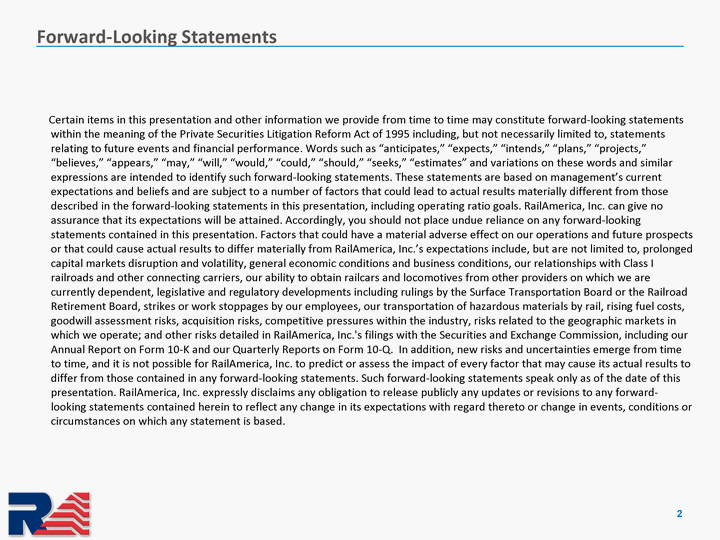
| Forward-Looking Statements 2 Certain items in this presentation and other information we provide from time to time may constitute forward-looking statements within the meaning of the Private Securities Litigation Reform Act of 1995 including, but not necessarily limited to, statements relating to future events and financial performance. Words such as "anticipates," "expects," "intends," "plans," "projects," "believes," "appears," "may," "will," "would," "could," "should," "seeks," "estimates" and variations on these words and similar expressions are intended to identify such forward-looking statements. These statements are based on management's current expectations and beliefs and are subject to a number of factors that could lead to actual results materially different from those described in the forward-looking statements in this presentation, including operating ratio goals. RailAmerica, Inc. can give no assurance that its expectations will be attained. Accordingly, you should not place undue reliance on any forward-looking statements contained in this presentation. Factors that could have a material adverse effect on our operations and future prospects or that could cause actual results to differ materially from RailAmerica, Inc.'s expectations include, but are not limited to, prolonged capital markets disruption and volatility, general economic conditions and business conditions, our relationships with Class I railroads and other connecting carriers, our ability to obtain railcars and locomotives from other providers on which we are currently dependent, legislative and regulatory developments including rulings by the Surface Transportation Board or the Railroad Retirement Board, strikes or work stoppages by our employees, our transportation of hazardous materials by rail, rising fuel costs, goodwill assessment risks, acquisition risks, competitive pressures within the industry, risks related to the geographic markets in which we operate; and other risks detailed in RailAmerica, Inc.'s filings with the Securities and Exchange Commission, including our Annual Report on Form 10-K and our Quarterly Reports on Form 10-Q. In addition, new risks and uncertainties emerge from time to time, and it is not possible for RailAmerica, Inc. to predict or assess the impact of every factor that may cause its actual results to differ from those contained in any forward-looking statements. Such forward-looking statements speak only as of the date of this presentation. RailAmerica, Inc. expressly disclaims any obligation to release publicly any updates or revisions to any forward- looking statements contained herein to reflect any change in its expectations with regard thereto or change in events, conditions or circumstances on which any statement is based. |
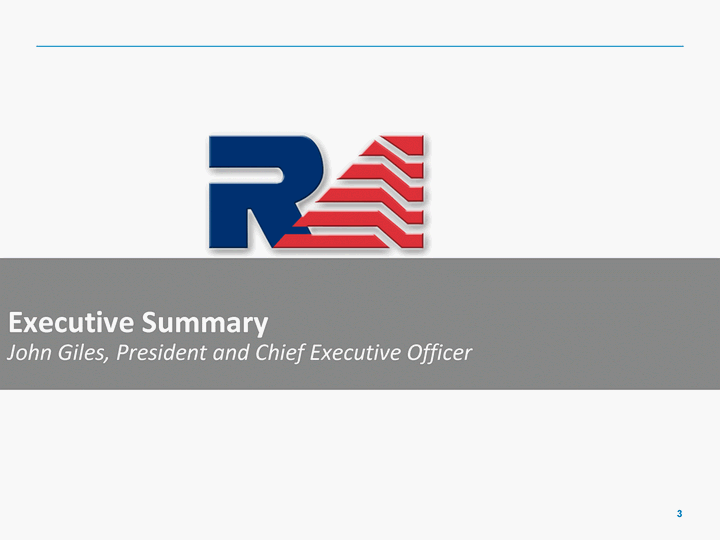
| Executive Summary John Giles, President and Chief Executive Officer 3 |
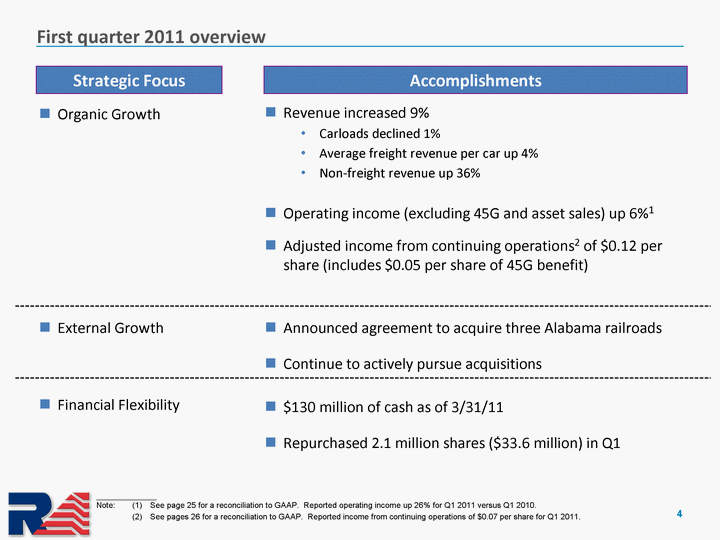
| First quarter 2011 overview 4 Strategic Focus Accomplishments Organic Growth External Growth Financial Flexibility Revenue increased 9% Carloads declined 1% Average freight revenue per car up 4% Non-freight revenue up 36% Operating income (excluding 45G and asset sales) up 6%1 Adjusted income from continuing operations2 of $0.12 per share (includes $0.05 per share of 45G benefit) Announced agreement to acquire three Alabama railroads Continue to actively pursue acquisitions $130 million of cash as of 3/31/11 Repurchased 2.1 million shares ($33.6 million) in Q1 ______________________ Note: (1) See page 25 for a reconciliation to GAAP. Reported operating income up 26% for Q1 2011 versus Q1 2010. (2) See pages 26 for a reconciliation to GAAP. Reported income from continuing operations of $0.07 per share for Q1 2011. |

| Commercial Update Charlie Patterson, Chief Commercial Officer 5 |

| 6 ($in millions) Q1 2011 revenue up $10 million versus Q1 2010. Increases in rate, mix, fuel surcharge and non-freight offset modest volume decline. Freight Revenue $2.8 First quarter 2011 revenue up 9% ______________________ Note: Numbers may not add or recalculate due to rounding. + 9% |
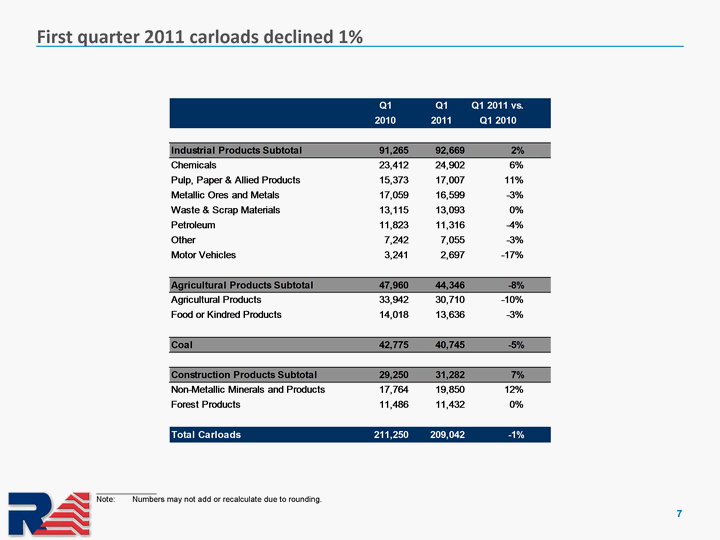
| First quarter 2011 carloads declined 1% 7 ______________________ Note: Numbers may not add or recalculate due to rounding. |

| First quarter 2011 average freight revenue per carload up 4% 8 Change in Average Freight Revenue per Carload (Versus Prior Year Period) Core price increases in the 3% range continue. |

| First quarter non-freight revenue up 36% 9 ______________________ Note: Numbers may not add or recalculate due to rounding. Non-freight revenue (reported) grew 36% driven by solid growth in all areas except car hire. Excluding Atlas, non-freight revenue grew 22%. |

| Operational Update John Giles, President and Chief Executive Officer 10 |

| Continued focus on operating ratio improvement 11 Operating Ratio - before 45G benefit and asset sales negatively impacted by fuel, weather and severance costs Fuel expense up 150 basis points Other expenses down 110 basis points Weather-related costs of approximately $2 million ______________________ Note: (1) See page 25 for a reconciliation to GAAP. (2) Numbers may not add or recalculate due to rounding. |

| Project Horizon Update Horizon is a project to reengineer and automate back office processes (order to cash) 34 of 40 roads converted (As of 4/21/11) All roads transitioned by mid-2011 $10 to $12 million EBITDA once fully implemented Beginning to capture benefits, remainder to be realized as system is fully transitioned Key milestones Centralized collections, billing, and car hire Closed Canadian and Kansas customer service centers Will close Oregon customer service center in Q2 Automation is increasing on roads where Horizon is in place ~ 72% automation of waybills and bills of lading ~ 67% automation of car movement data ~ 57% automation of customer release of empty cars Automation will increase as newly implemented roads and customers more fully adopt the systems 12 |

| Safety remains a critical area of focus 13 ______________________ Note: RailAmerica includes Canadian railroads and excludes Atlas. PI ratio rate per 200,000 man hours worked. FRA = Federal Railroad Administration. FRA Reportable Train Accidents Q1 FRA Reportable Train Accident Ratio Q1 |

| Announced agreement to acquire three Alabama railroads; expected to close in Q2 2011 Three railroads in Alabama comprising 70 miles hauling primarily agricultural and chemical products. $12.7 million purchase price (using cash on hand). Close proximity to other RA properties (Alabama & Gulf Coast Railway and Eastern Alabama Railway). Located in geographic area with attractive growth characteristics. Financial outlook for the next twelve months: $3.7 million in revenue $1.2 million in operating income $0.7 million in depreciation and amortization 14 * * * ______________________ Note: * Three Notch Railroad (THNR), Wiregrass Central Railroad (WGCR) and Conecuh Valley Railroad (COEH) |

| Financial Update Clyde Preslar, Chief Financial Officer 15 |

| First quarter 2011 EPS totaled $0.07 per share including 45G benefit 16 ______________________ Note: Numbers may not add due to rounding. NM = not meaningful. |
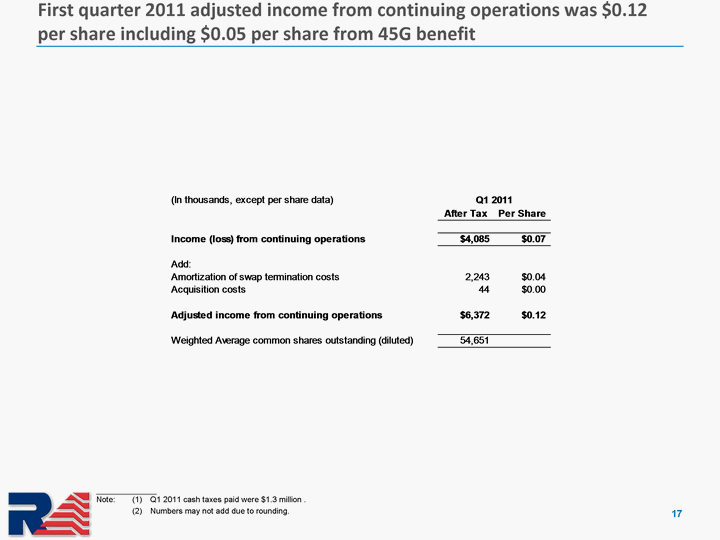
| First quarter 2011 adjusted income from continuing operations was $0.12 per share including $0.05 per share from 45G benefit 17 ______________________ Note: (1) Q1 2011 cash taxes paid were $1.3 million . (2) Numbers may not add due to rounding. |

| First quarter 2011 detailed results compared to prior year 18 ______________________ Note: (1) See page 25 for a reconciliation to GAAP. |
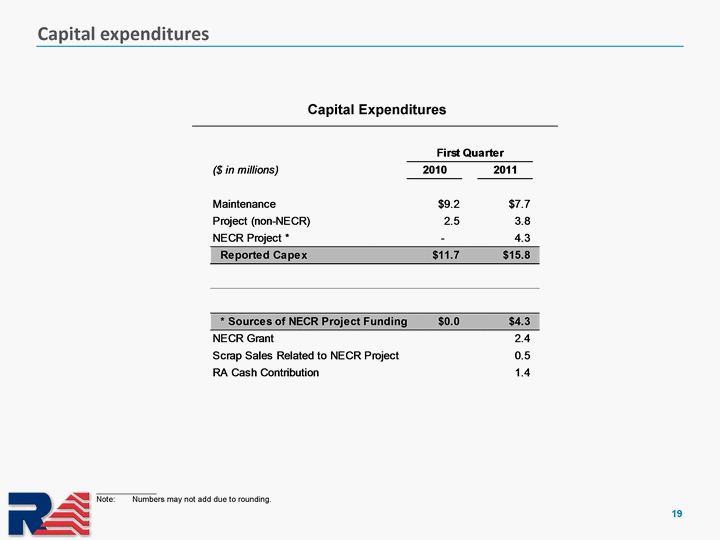
| Capital expenditures 19 Capital Expenditures ______________________ Note: Numbers may not add due to rounding. |

| Favorable tax attributes enhance cash flow and value to shareholders 20 Federal net operating loss carryforward (NOL's) of $79 million (as of 12/31/10) Unused 45G tax credits of $95 million (as of 12/31/10) 45G tax credits approved for 2011 Expect to pay minimal cash taxes over the next 5+ years First quarter 2011 summary Financial statement income tax expense: $2.1 million Cash taxes paid: $1.3 million |

| Strong capital structure supports organic growth and strategic investments 21 Capitalization ______________________ Note: Numbers may not add due to rounding. |

| Q2 and full year estimates 22 ______________________ Note: (1) Assumes no acquisitions or debt repayment and does not include interest income on cash balances. (2) Assumes ~ $13 million in full year project capital. (3) Assumes ~ $38 million in grant proceeds (full year) and ~$14 million in scrap proceeds (full year) to help fund investment |
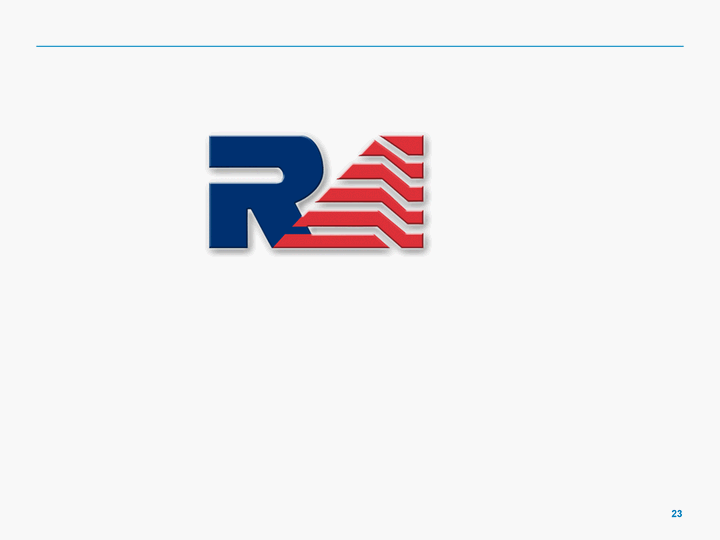
| 23 |

| Appendix 24 |

| Operating Income and Operating Ratio Before 45G Benefit Reconciliation to GAAP & Operating Income and Operating Ratio Before 45G Benefit and Asset Sales Reconciliation to GAAP 25 Operating Income Before 45G Benefit, Operating Ratio Before 45G Benefit, Operating Income Before 45G Benefit and Asset Sales and Operating Ratio Before 45G Benefit and Asset Sales are supplemental measures of profitability that are not calculated or presented in accordance with U.S. generally accepted accounting principles ("GAAP"). We use non-GAAP financial measures as a supplement to our GAAP results in order to provide a more complete understanding of the factors and trends affecting our business. However, Operating Income Before 45G Benefit, Operating Ratio Before 45G Benefit, Operating Income Before 45G Benefit and Asset Sales and Operating Ratio Before 45G Benefit and Asset Sales have limitations as an analytical tool. They are not measurements of our profitability under GAAP and should not be considered as an alternative to Operating Income or Operating Ratio as a measure of profitability. Operating Income Before 45G Benefit and Operating Ratio Before 45G Benefit assists us in measuring our performance and profitability of our operations without the impact of monetizing the 45G Tax Benefit. Operating Income Before 45G Benefit and Asset Sales and Operating Ratio Before 45G Benefit and Asset Sales assists us in measuring our performance and profitability of our operations without the impact of monetizing the 45G Tax Benefit and Asset Sales. The following table sets forth the reconciliation of Operating Income Before 45G Benefit from our Operating Income, Operating Ratio Before 45G Benefit from our Operating Ratio, Operating Income Before 45G Benefit and Asset Sales from our Operating Income and Operating Ratio Before 45G Benefit and Asset Sales from our Operating Ratio. ______________________ Note: (1) Numbers may not add due to rounding. |

| Adjusted income from continuing operations reconciliation to GAAP 26 ______________________ Note: (1) Numbers may not add due to rounding. Adjusted income from continuing operations is a supplemental measure of profitability that is not calculated or presented in accordance with U.S. generally accepted accounting principles ("GAAP"). We use non-GAAP financial measures as a supplement to our GAAP results in order to provide a more complete understanding of the factors and trends affecting our business. However, Adjusted income from continuing operations has limitations as an analytical tool. It is not a measurement of our profitability under GAAP and should not be considered as an alternative to Income (loss) from continuing operations as a measure of profitability. Adjusted income from continuing operations assists us in measuring our performance and profitability of our operations without the impact of foreign exchange loss (gain) on debt and transaction costs related to debt extinguishment, acquisitions and swap termination. The following table sets forth the reconciliation of Adjusted income from continuing operations. |

| Adjusted EBITDA reconciliation to GAAP 27 Adjusted EBITDA, is a supplemental measure of liquidity that is not calculated or presented in accordance with U.S. generally accepted accounting principles ("GAAP"). We use non-GAAP financial measures as a supplement to our GAAP results in order to provide a more complete understanding of the factors and trends affecting our business. However, Adjusted EBITDA has limitations as an analytical tool. It is not a measurement of our cash flows from operating activities under GAAP and should not be considered as an alternative to cash flow from operating activities as a measure of liquidity. Adjusted EBITDA assists us in monitoring our ability to undertake key investing and financing functions such as making investments, transferring property, paying dividends, and incurring additional indebtedness, which are generally prohibited by the covenants under our senior secured notes unless we met certain financial ratios and tests. Adjusted EBITDA represents EBITDA before impairment of assets, equity compensation costs, gain (loss) on foreign currency exchange, acquisition costs and non-recurring headquarter relocation costs. EBITDA, also a non-GAAP financial measure, is defined as net income (loss) before interest expense, provision for (benefit from) income taxes and depreciation and amortization. The following tables set forth the reconciliation of Adjusted EBITDA from our cash flow from operating activities (in thousands): |
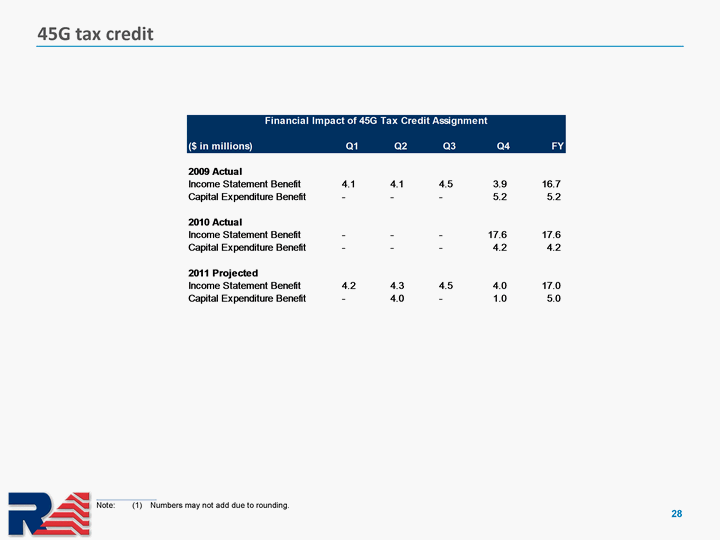
| 45G tax credit 28 ______________________ Note: (1) Numbers may not add due to rounding. |
